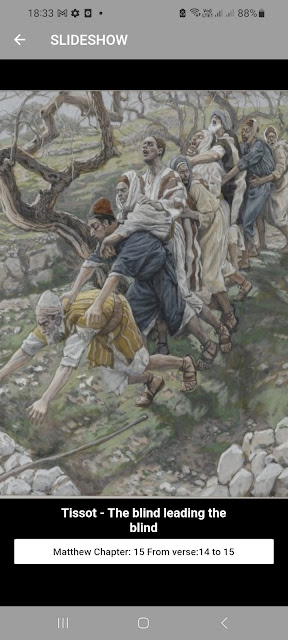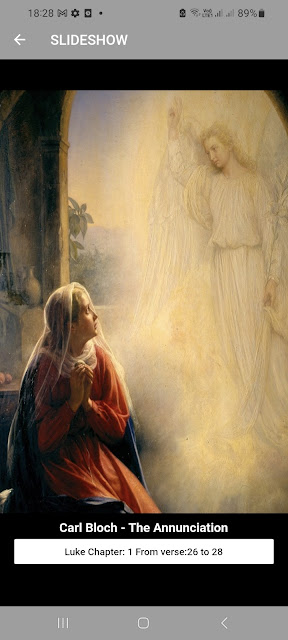Enjoy our Biblical Paintings Images app with about 1,000 paintings from the New and Old Testaments. Below is a depiction of a few paintings with some commentary.
a) Tissot The blind leading the blind Matt 15:14
The phrase "the blind leading the blind" is found in the Bible in the New Testament book of Matthew, chapter 15, verse 14. In this passage, Jesus is speaking to the crowd about the Pharisees and scribes, who were the religious leaders of his time. He tells the crowd to "Let them alone: they are blind leaders of the blind. And if the blind lead the blind, both shall fall into the ditch."
This passage is a warning against following false leaders who are spiritually blind and cannot lead their followers on the right path. The Lord is saying that if people follow such leaders, they will end up falling into a ditch, which is a metaphor for spiritual destruction or ruin. The Lord is criticizing the Pharisees for their lack of spiritual insight and their tendency to mislead others by teaching false doctrines. He is saying that if someone who is spiritually blind tries to lead others who are also spiritually blind, both the leader and the followers will end up in trouble.
c) Carl Bloch Annunciation
The Annunciation is one of the most important events in theology. It is often depicted in art, and many artists have created paintings, sculptures, and other works inspired by the story.
The event is significant for several reasons. First, it marks the beginning of the Incarnation, the belief that Jesus is the Son of God who became a human being to save humanity from sin. In this sense, the Annunciation is a key moment in the Christian story of salvation.
Second, it is also significant for what it reveals about the character of Mary. She is depicted as a humble and faithful servant of God, who is willing to submit to God's will, even if it means accepting a difficult and challenging role. Her response to the angel's message, "Let it be to me according to your word," is an example of her faith and trust in God.
Finally, the Annunciation also signifies the importance of women in the story. Mary is a central figure and her role as the mother of Christ is essential to the understanding of the Incarnation. Her faith and obedience to God's will are an inspiration to many Christians, especially women, who see her as a model of faith and devotion.
d) Francesco Madonna
Benvenuto Madonna and Baby sleeping
Bougearau - The blessed virgin with angels
The Madonna and Child is a common subject in Christian art, especially in the medieval and Renaissance periods. The term "Madonna" is an Italian word that means "my lady," and it is used to refer to the Virgin Mary, who is often depicted in art holding an infant.
The paintings typically show Mary sitting or standing, holding the baby in her arms. The images often include a halo or other symbols that indicate their divine nature. They are usually highly stylized, with Mary and Jesus portrayed in idealized forms, often surrounded by elaborate backgrounds and ornamental details.
One of the reasons why the subject is so popular in Christian art is because it reflects the central belief that Christ is both fully divine and fully human. The paintings of Mary holding Christ in her arms represent the Incarnation, the belief that God became human and entered the world as a baby. The image is a powerful visual representation of this concept, and it has inspired countless artists throughout history.
In addition to its theological significance, the Madonna and Child subject has also been used to convey a range of emotions and ideas. Some paintings show Mary as a loving and protective mother, while others depict her as a sorrowful figure, mourning the death of her son. The paintings have been used to express ideas about love, compassion, sacrifice, and devotion, and they continue to be an important part of Christian art and culture today.
g) Renaissance Cezanne Christ in Limbo
Angelico - Christ in Limbo
The idea of Christ in Limbo, or the Harrowing of Hell, is rooted in early theology and has been a significant aspect of belief and practice for centuries. It refers to the period between Jesus' death on the cross and his resurrection, during which he is believed to have descended into Hell to free the souls of the righteous who had died before his coming.
The concept is based on several passages in the Bible, including 1 Peter 3:19-20, which speaks of the Lord preaching to the spirits in prison, and Ephesians 4:9-10, which refers to Him descending into the lower parts of the earth. These passages, along with other early texts, led to the development of the belief that He descended into Hell to free the souls of the righteous who were waiting for their redemption.
The idea became a central aspect of Christian theology and was incorporated into the creeds of many early Christian communities. It was also an important theme in early art and literature, and the imagery associated with the Harrowing of Hell became a powerful symbol of salvation and redemption.
In art, the Harrowing of Hell is often depicted as a triumphant scene, with Jesus breaking down the gates of Hell and rescuing Adam and Eve, along with other Old Testament figures. This imagery is meant to symbolize His triumph over sin and death and to emphasize the belief that through his sacrifice and resurrection, all people can be redeemed and saved.
The concept continues to be an important part of Christianity and it is celebrated in many traditions, including the Eastern Orthodox Church, which observes the Feast of the Descent of the Holy Spirit into Hades. The Catholic church does not celebrate as such, but the day is recognized as Holy Saturday, with no masses being celebrated on the day.
The idea of Christ descending into Hell to free the souls of the righteous is a powerful reminder of the hope and redemption that are available to all people through the sacrifice and resurrection of our Lord.
Enjoy







